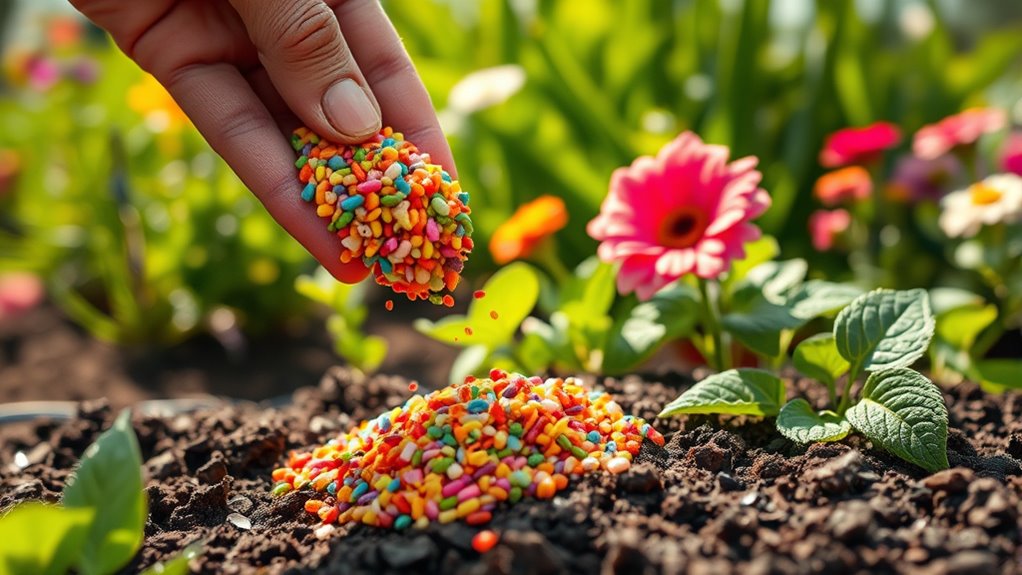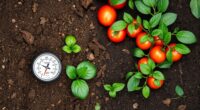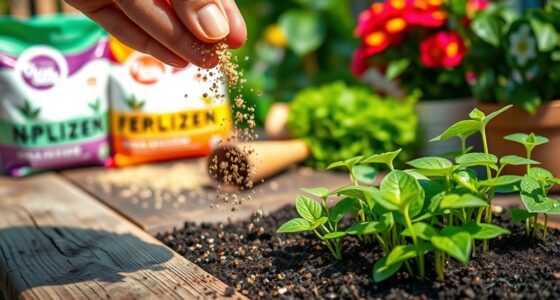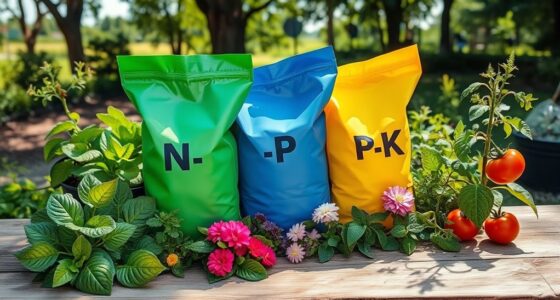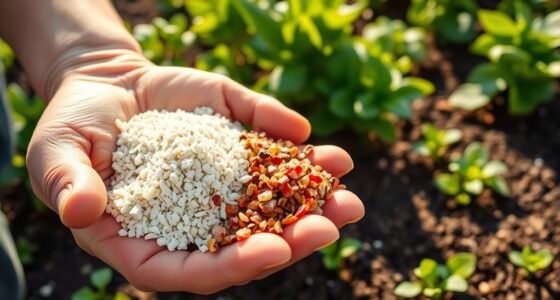Fertilizer 101 explains how N-P-K stands for nitrogen, phosphorus, and potassium—key nutrients your plants need for healthy growth. Nitrogen encourages lush foliage, phosphorus supports root and flower development, and potassium helps overall plant health. But plants also require trace minerals like magnesium and calcium, which soil testing can reveal. Choosing the right fertilizer depends on understanding your soil’s current nutrients and pH level. Keep exploring to learn how to tailor fertilization for your garden’s success.
Key Takeaways
- N-P-K stands for nitrogen, phosphorus, and potassium, essential macronutrients for plant growth.
- The right fertilizer depends on soil nutrient levels, which soil testing can determine.
- Synthetic fertilizers provide immediate nutrients, while organic options improve soil health over time.
- Trace minerals beyond N-P-K are vital for overall plant health and should be considered.
- Sustainable fertilization involves balancing nutrient needs with environmental impact, guided by soil testing.
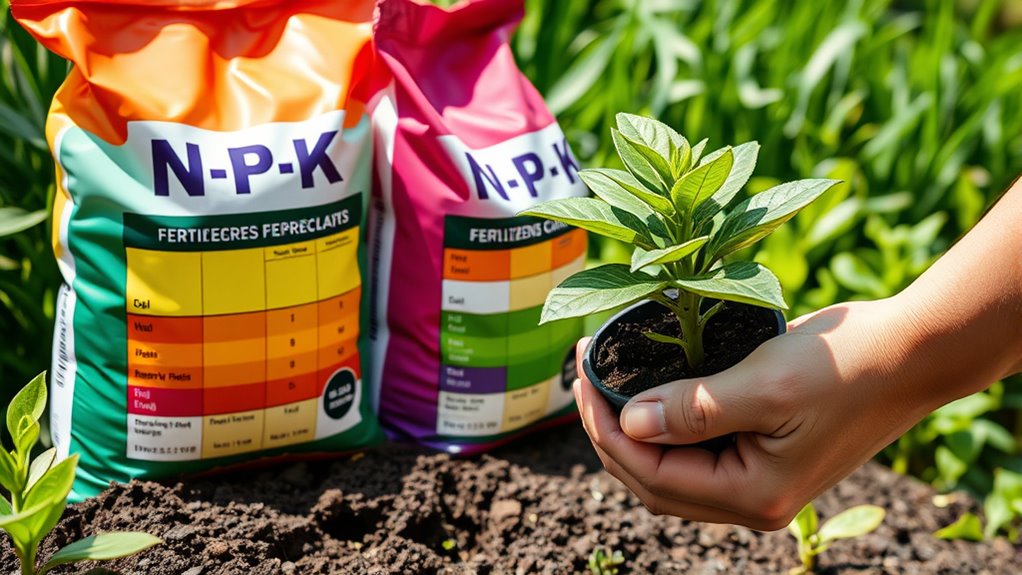
Have you ever wondered how plants thrive and produce abundant yields? The secret often lies beneath the surface, in the soil you’re growing them in. Before adding any fertilizer, it’s essential to understand your soil’s needs, which is where soil testing comes into play. Soil testing provides critical information about nutrient levels, pH balance, and overall soil health. This step helps you determine whether your plants need specific nutrients or if the soil already has enough. Knowing this allows you to make informed decisions, preventing over-fertilization or deficiencies that could hinder growth. When considering fertilizers, you’ll notice a debate between organic and synthetic options. Organic fertilizers are derived from natural sources like compost, manure, or plant extracts. They tend to improve soil structure, enhance microbial activity, and release nutrients slowly over time. Synthetic fertilizers, on the other hand, are manufactured chemical compounds designed to provide immediate nutrient availability. They often contain concentrated forms of nitrogen, phosphorus, and potassium—collectively known as N-P-K—aimed at quickly boosting plant growth. The choice between organic and synthetic depends on your gardening goals, environmental considerations, and soil condition. Organic fertilizers usually promote sustainable practices, enriching the soil for long-term health, but may take longer to show results. Synthetic options can deliver rapid nutrient uptake, which is beneficial when plants are in urgent need of nutrients or when precise control is necessary. However, overuse of synthetic fertilizers risks soil degradation, runoff, and harming beneficial soil microbes. That’s why soil testing is particularly important if you’re leaning toward synthetic fertilizers, ensuring you don’t apply more than what’s needed. Conversely, if you prefer organic methods, soil testing helps you identify deficiencies that compost or natural amendments can address, avoiding unnecessary additions. Additionally, understanding the specific environmental impact of different fertilizers can guide more sustainable practices. Regardless of your choice, understanding the balance of nutrients in your soil allows you to tailor your fertilization approach effectively. Remember, plants need more than just N-P-K; they require a spectrum of trace minerals and proper pH levels for ideal growth. Soil testing gives you a clear picture, guiding you toward the right fertilizers and application rates. By combining this knowledge with your fertilizer choice, you’ll be better equipped to nurture healthy, productive plants. In essence, knowing your soil’s condition and understanding the organic versus synthetic debate empowers you to create a thriving garden or farm, ensuring your plants get exactly what they need to flourish.
Frequently Asked Questions
How Do I Choose the Right Fertilizer for My Specific Plants?
When selecting the right fertilizer, you need to account for your plant’s nutrient balance and specific needs. Think about the type of plants you have—vegetables, flowers, or trees—and their growth stage. Pay attention to fertilizer application timing to guarantee nutrients are available when plants need them most. Choose a fertilizer with the appropriate N-P-K ratio, and follow label instructions for peak results tailored to your plants’ health.
Can Over-Fertilizing Harm My Plants or the Environment?
Imagine pouring a giant bucket of fertilizer onto your plants—over-fertilizing can turn your garden into a toxic wasteland! Excess nutrients cause plant toxicity, making leaves burn and roots die. Plus, fertilizer runoff washes harmful chemicals into nearby water sources, harming aquatic life. So, always follow recommended amounts; too much can devastate your plants and pollute the environment, turning your lush garden into a dangerous, toxic zone.
What Are Organic Versus Synthetic Fertilizers?
You might wonder about organic versus synthetic fertilizers. Organic options, like compost or manure, are natural and chemical-free, enriching soil gradually. Synthetic fertilizers are chemical-based and designed for quick nutrient release. While compost and manure improve soil health naturally, chemical fertilizers provide immediate nutrients but can harm the environment if overused. Choosing between them depends on your plants’ needs and your gardening goals.
When Is the Best Time of Year to Fertilize Different Plants?
Like a maestro conducts an orchestra, timing matters for your plants’ growth. You should fertilize seasonal planting at key growth stages—early spring for vegetables, late summer for flowering plants. Stick to consistent fertilizer schedules, adjusting for plant type and climate. Avoid over-fertilizing in winter when growth slows. By aligning fertilization with natural cycles, you’ll guarantee healthy, vibrant plants year-round, just as nature intended.
How Do Soil Ph Levels Affect Fertilizer Effectiveness?
Soil pH levels considerably impact fertilizer effectiveness because soil acidity affects fertilizer solubility. If your soil is too acidic or alkaline, nutrients may not dissolve properly, making them less available to your plants. To optimize fertilization, test your soil pH regularly. Adjusting soil acidity with amendments like lime or sulfur can improve fertilizer solubility, ensuring your plants absorb the nutrients they need for healthy growth.
Conclusion
Now that you’ve learned about N-P-K and what your plants need, you’re ready to make smarter fertilizing choices. Remember, each plant has unique requirements, so pay attention to their signals and adjust accordingly. Will you take the time to nourish your plants properly and watch them thrive? By understanding these basics, you can create a healthier, more productive garden. So, why not start applying what you’ve learned today and see the difference for yourself?
